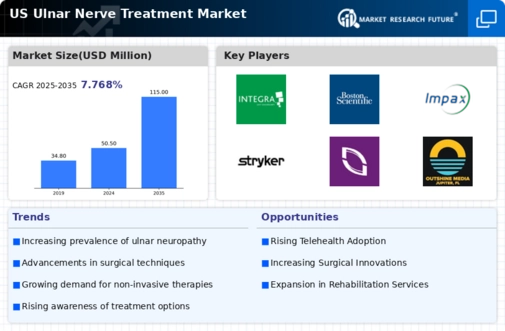Growing Geriatric Population
The demographic shift towards an aging population in the US is a crucial driver for the ulnar nerve-treatment market. As individuals age, the likelihood of developing musculoskeletal disorders, including ulnar nerve entrapment, increases. By 2030, it is estimated that nearly 20% of the US population will be over 65 years old, creating a substantial demand for specialized healthcare services. This trend necessitates the development of targeted treatment protocols and rehabilitation programs tailored to the needs of older adults. Consequently, the ulnar nerve-treatment market must prepare for an influx of patients requiring comprehensive care, thereby influencing market dynamics and growth trajectories.
Advancements in Surgical Techniques
Innovations in surgical techniques are significantly impacting the ulnar nerve-treatment market. Minimally invasive procedures, such as endoscopic ulnar nerve decompression, have gained traction, offering patients reduced recovery times and improved outcomes. The adoption of these advanced techniques is expected to increase, as they align with the growing preference for outpatient procedures. Furthermore, the market is projected to witness a shift towards robotic-assisted surgeries, which may enhance precision and reduce complications. As these advancements become more prevalent, the ulnar nerve-treatment market is likely to expand, catering to a broader patient demographic seeking effective and less invasive treatment options.
Rising Incidence of Ulnar Nerve Disorders
The ulnar nerve-treatment market is experiencing growth due to the increasing incidence of ulnar nerve disorders, such as cubital tunnel syndrome and ulnar neuropathy. According to recent data, approximately 1 in 1,000 individuals in the US are diagnosed with these conditions annually. This rising prevalence is likely to drive demand for effective treatment options, including surgical interventions and conservative management strategies. As the population ages, the incidence of these disorders may further escalate, necessitating a robust response from healthcare providers. The ulnar nerve-treatment market must adapt to these trends by enhancing treatment protocols and ensuring accessibility to care for affected individuals.
Rising Demand for Non-Invasive Treatment Options
The ulnar nerve-treatment market is witnessing a shift towards non-invasive treatment options, driven by patient preferences for less aggressive interventions. Techniques such as physical therapy, corticosteroid injections, and ergonomic modifications are gaining popularity as first-line treatments. This trend is supported by a growing body of evidence suggesting that conservative management can be effective in alleviating symptoms for many patients. As awareness of these options increases, healthcare providers are likely to incorporate them into standard treatment protocols. The ulnar nerve-treatment market must adapt to this demand by ensuring that practitioners are well-versed in non-invasive strategies, ultimately enhancing patient satisfaction and treatment adherence.
Increased Investment in Healthcare Infrastructure
Investment in healthcare infrastructure is a pivotal factor influencing the ulnar nerve-treatment market. The US government and private sector are channeling resources into enhancing healthcare facilities, which includes the establishment of specialized clinics for nerve-related disorders. This investment is expected to improve access to care and facilitate the implementation of advanced treatment modalities. Furthermore, the expansion of telemedicine services is likely to play a role in reaching underserved populations, thereby broadening the market's reach. As healthcare infrastructure continues to evolve, the ulnar nerve-treatment market stands to benefit from improved patient outcomes and increased service availability.

















Leave a Comment